TIG (GTAW) welding is one of the cleanest and best ways to weld aluminum. TIG welding allows maximum control over every aspect of the welding process, resulting in high-quality, clean weld beads that look amazing.
The issue with TIG welding aluminum is that it can be daunting for beginner welders.
This article aims to take some of the edge off any nervousness by offering a comprehensive guide you can follow.
Why Use TIG Welding for Aluminum?
TIG welding is the best choice for aluminum projects due to its precise heat management, versatile filler metal options, and clean operation.

© weldguru.com – Image usage rights
First and foremost, aluminum requires accurate heat control because of its low melting point and sensitivity to overheating. TIG welding excels in this area, ensuring the metal is not damaged during the process.
Additionally, TIG welding offers a wide range of filler metals. This allows you to match the filler metal’s mechanical properties to those of the base metal, giving you the exact characteristics you need.
You can even use a piece of the parent metal as your filler to guarantee a perfect match.
Finally, TIG welding features AC balance control, which increases the cleaning action on aluminum welds, making the whole operation cleaner and more efficient.
Is TIG Welding Aluminum Difficult?
TIG welding is challenging because it requires good hand-eye coordination, a steady hand, and attention to detail.
The good news is that with practice, you can become a proficient TIG welder in no time at all.
One thing that helped a lot when I was learning to TIG weld was having as many tips and tricks as possible to guide me in the learning process.
Preparing for TIG Welding Aluminum
The actual welding of the aluminum is secondary to the preparation that must take place. Failure to prepare before an aluminum TIG weld will cause you unneeded frustration and poor-quality welds.
Always take the time to prepare your equipment and material before every TIG weld.
Surface Preparation
TIG welding requires that the material be spotless and free from any contaminants. On more occasions than I care to admit, I’ve tried to skip this step, which has always resulted in bad welds and a lot of grinding.
One aspect of aluminum you need to deal with first is the oxide layer on the surface.
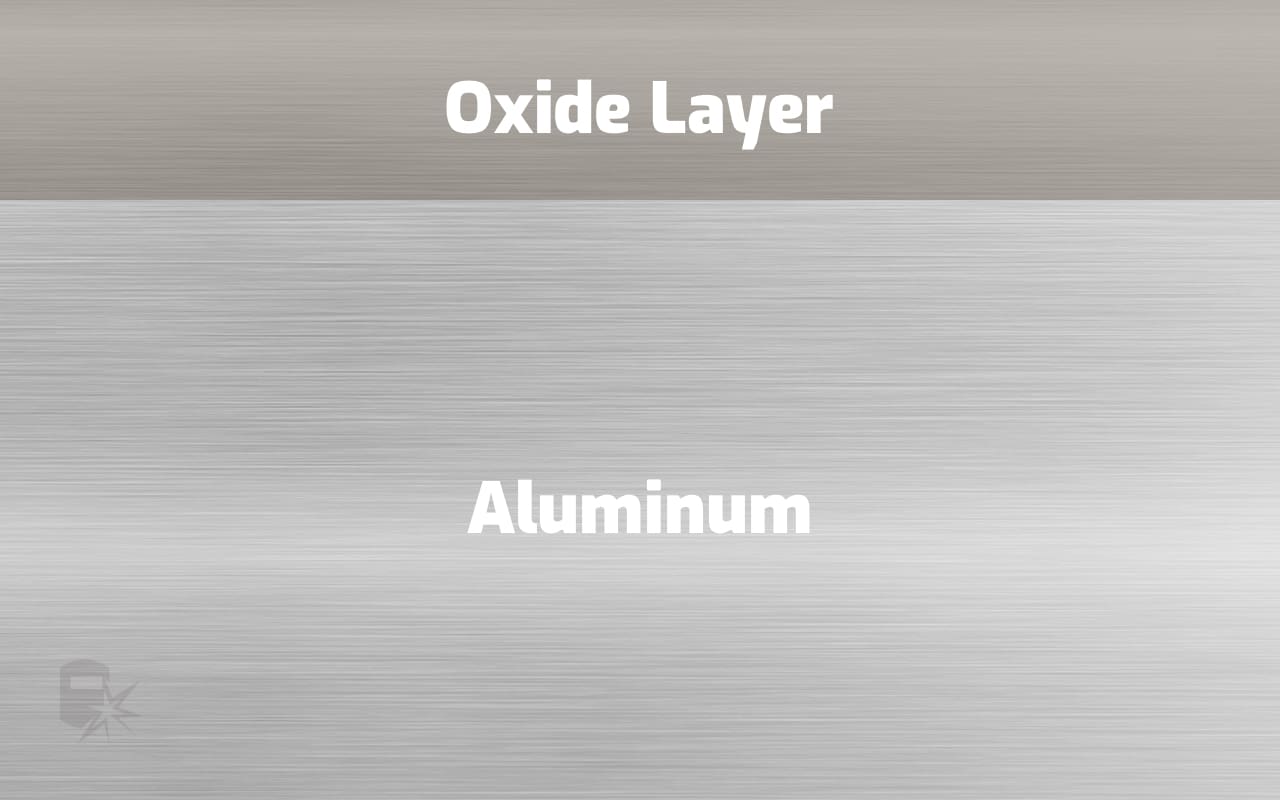
© weldguru.com – Image usage rights
This oxide layer melts at a higher temperature, over two times the melting point than the base metal, so you’ll be pumping far too much heat into the weld joint to get a liquid puddle. This is when you’ll completely burn through the parent metal.
Therefore, you need to remove the oxide with a stainless steel wire brush that you only use for aluminum and nothing else.
An alternating current (AC) will also remove the oxide layer from the parent metal, acting like sandblasting, which you can see happening if you look closely while welding.
You just need to ensure your filler rod isn’t blocking the parent metal; you can do this by using the dabbing technique. We’ll talk more about the dabbing technique in the tips for welding aluminum section.
The surface of the metal also needs to be spotless. No dirt, grime, oils, or other contaminants should be on the surface. Wipe the surface with a solvent that won’t leave any residue behind.
Shielding Gas for TIG Welding Aluminum
When selecting a shielding gas for TIG welding of aluminum, you have three options: argon, helium, and mixed gases.
Argon – Argon has several advantages, like good arc stability, penetration, and minimal spatter. Since the arc is stable, it’s good for precision welding and thin aluminum sheets. This will also be your least expensive option.
Helium – Helium has higher heat conductivity than argon, giving more heat input to the weld puddle. This is good for welding thicker aluminum plates, giving better penetration and faster travel speeds. But it gives a more erratic arc than argon, which may require more skill and control.
Mixed Gas – In some cases, you’ll need a blend of argon and helium, known as a “mixed gas,” which combines the benefits of each gas. This allows specific mixtures of argon and helium for specific applications. For example, you can use a gas of 25% helium and 75% argon, increasing the heat input while maintaining arc stability.
For 90% of the aluminum TIG welding you’ll do, 100% argon will serve you very well.
Tungsten Selection
Tungsten selection is crucial for TIG welding of aluminum, which can be confusing because there are many options.
The list below details the common tungsten choices for aluminum and why you should consider them. Disclaimer: I added affiliate links to some recommended brands that I’ve used myself.
Pure Tungsten (green) – The most popular choice is the pure tungsten electrode. They have good high-temperature stability with a clean, stable arc. They don’t have high current carrying capability, so you would use them for thinner aluminum. Since no alloys are in this tungsten, it’s the least expensive choice.
Zirconiated Tungsten (brown) – These have a higher current carrying capacity than pure tungsten and produce a very stable arc. Zirconiated tungstens also keep their balled tip very well, which makes them great for AC welding.
Ceriated Tungsten (gray) or Lanthanated Tungsten (blue) – These tungsten alloys are good for AC and DC TIG welding of aluminum. They have good arc stability, long electrode life, and moderate current-carrying capacity. You’ll use ceriated tungsten for lower amperages and lanthanated tungsten for high amperage.
Thoriated Tungsten (red) – If you decide to TIG weld aluminum using DC, you’ll probably choose a thoriated electrode. They have a high current-carrying and maintain a sharp tip, making them good for welding thicker aluminum sections.
Ceriated, lanthanated, and thoriated tungsten electrodes use an end tapered to a point. You would prepare the end of a pure tungsten and zirconiated electrode with a balled tip.
To ball the tip of a pure tungsten or zirconiated electrode:
- Square off the end of the electrode
- Switch the machine to DCEP or set the AC balance above 70% positive
- On a piece of clean copper or scrap aluminum, strike an arc using high frequency and hold the torch at 90 degrees to the plate
- Slowly ramp up the amperage and watch as the tip gets red and starts to ball
- Stop the arc when you get the shape you want
The size of the ball shouldn’t be more than 1.5 times the electrode diameter.
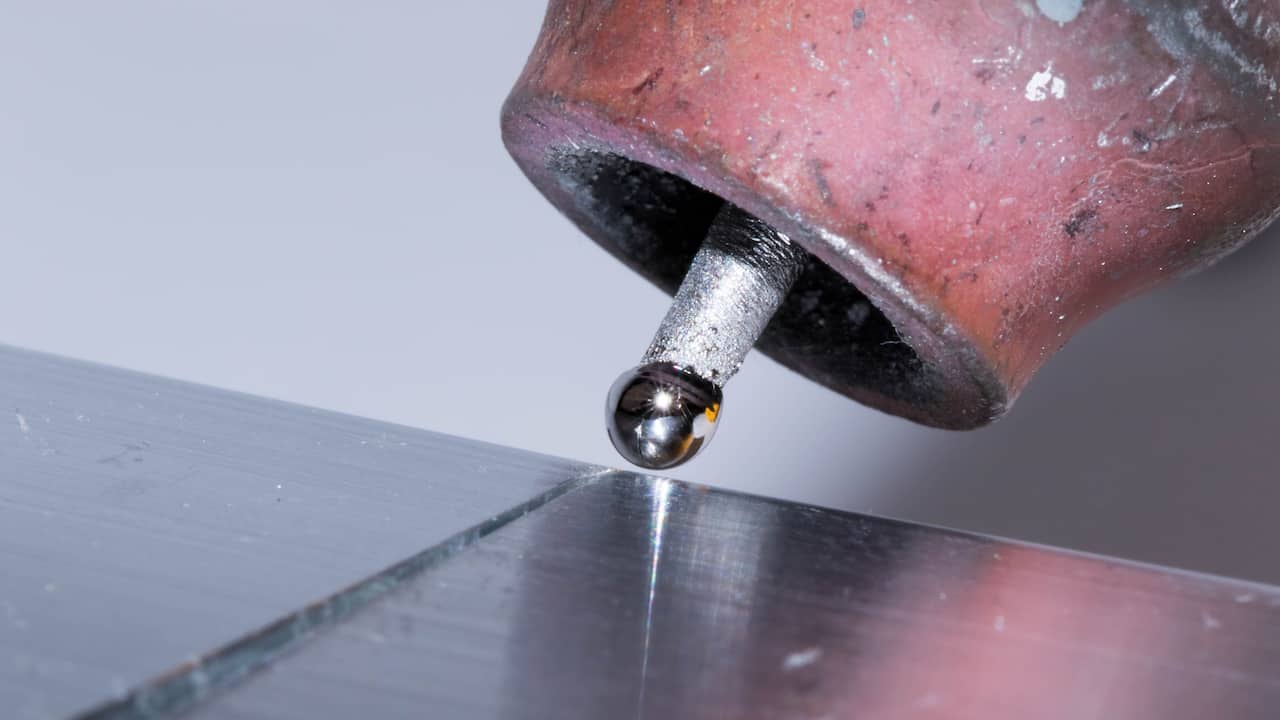
© weldguru.com – Image usage rights
While balling naturally occurs when you TIG weld aluminum, I like to do this scrap piece in case bits of the tungsten break off the electrode, which can cause inclusions.
Filler Rod Selection
The filler metal for aluminum TIG welding comes in long rods of aluminum alloys in various thicknesses. Generally speaking, you’ll select a rod thickness with a diameter smaller than the base metal thickness.
While there are many different filler metal compositions for aluminum TIG rods, there are two that the beginner welder most uses.
ER4043 – This filler alloy has added silicon, giving you a more fluid puddle and better wetting action. The welds will also look very nice with a bright finish and resist cracks. 4043 is a good option when you need a weld that can withstand temperatures above 150 degrees Fahrenheit, or you need the weld to have greater resistance to cracking. 4043 is also a better option than 5356 for welding on casings.
ER5356 – This is one of the more common filler metals, designed for 5000 series aluminum, and can also join 6000 series aluminum. Unlike 4043, 5356 isn’t good for service temperatures above 150 degrees Fahrenheit. If you have the finished weldment anodized, you’ll want to use 5356, and if you need a higher-strength weld, 5356 will be the better choice.
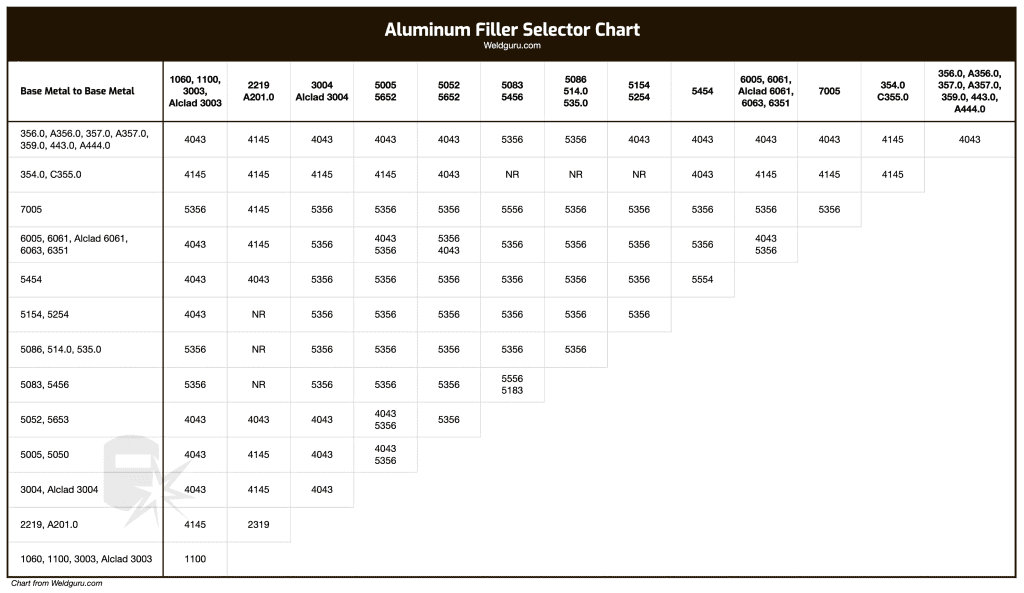
© weldguru.com – Image usage rights
While these will cover most of your aluminum TIG welding needs, other options are available depending on what grade of aluminum you plan on joining together. The above chart is a great resource for aluminum filler rod selection.
Safety
All welding carries with it risks of exposure to harmful fumes. In particular, you should avoid inhaling aluminum welding fumes as much as possible.
Aluminum welding creates tiny particles of aluminum and aluminum oxide, which the fumes carry into your lungs. These particles are small enough to cross the blood-brain barrier and build up in your brain.
Aluminum is a neurotoxin, and there’s a link between aluminum and Alzheimer’s disease as well as other neurological conditions.
Some other issues that you’ll face when inhaling aluminum welding fumes are:
- Irritation to the nose, throat, lungs, and skin
- Metal fume fever
- Lung diseases
- Aluminosis, which is scarring of the lungs, has symptoms of coughing and shortness of breath.
Moreover, TIG welding aluminum generates ozone. Short-term exposure can irritate the eyes, nose, throat, and lungs, and may lead to headaches and reduced lung function. Long-term effects include asthma and chronic lung disease.
Always weld aluminum in well-ventilated areas while wearing the appropriate PPE.
Also, if someone tells you to work in conditions where you’ll face exposure to aluminum welding fumes, you have a right to refuse to work in those conditions. On several occasions, I’ve refused to weld aluminum in confined spaces without the proper training, PPE, and ventilation.
Settings for TIG Welding Aluminum
Before getting started, there are a few important settings you need to understand and adjust, including the current, gas flow rate and amperage.
Do You TIG Weld Aluminum on AC or DC?
You’ll do most TIG welding of aluminum with AC at high frequency. Since the current is switching polarity rapidly, the AC arc has a good cleaning action on aluminum welds and also removes the oxide layer, exposing the base metal for easy welding.
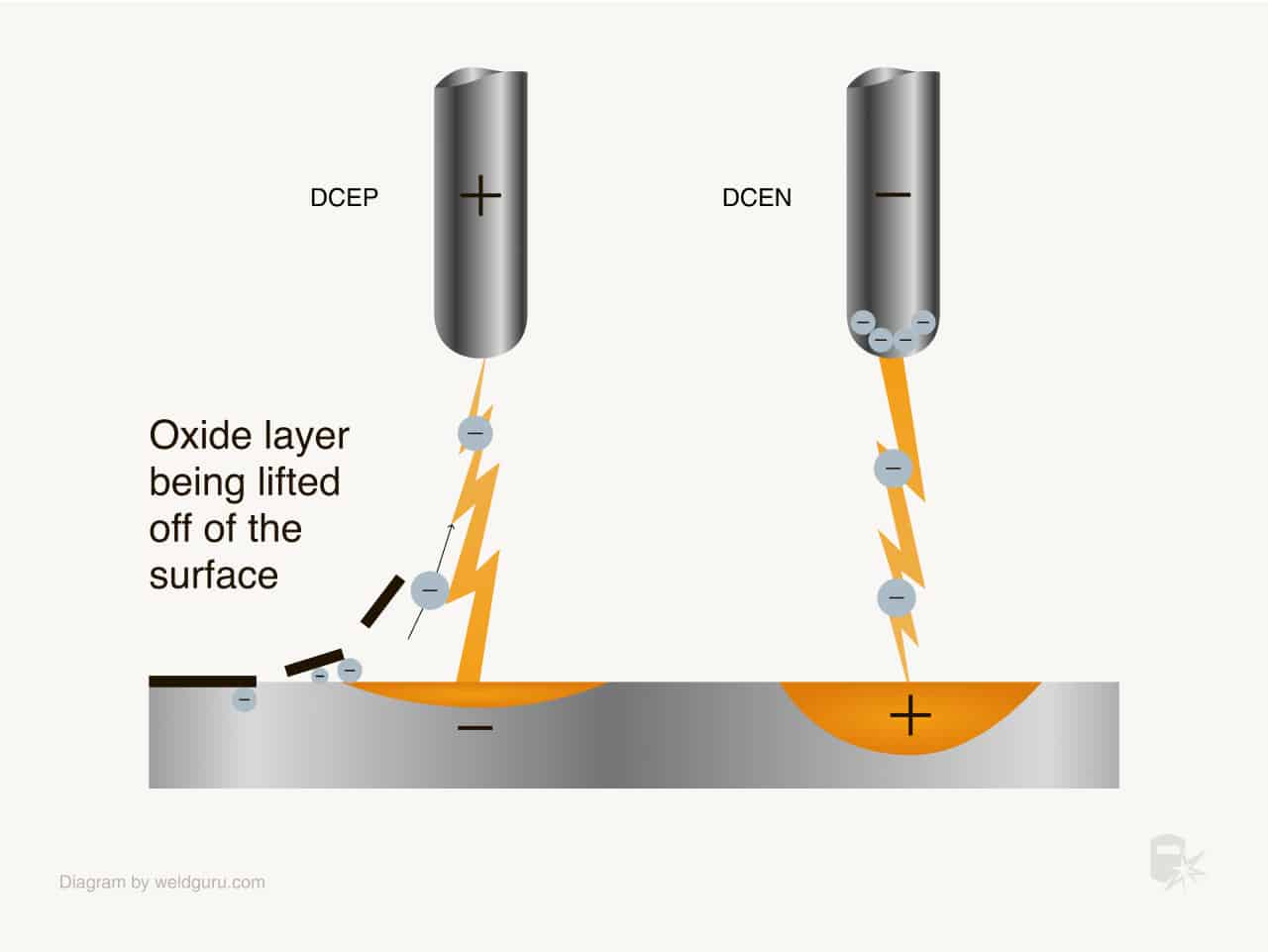
© weldguru.com – Image usage rights
If you were to weld aluminum with DC, you’d have less heat input and no cleaning action. On the other hand, you‘ll get more penetration, which could be good for thicker sections.
Recommended Argon Flow Rate for TIG Welding Aluminum
Setting your argon flow rate correctly is vital to get the best results in TIG welding aluminum.
A flow rate between 10 and 35 cubic feet per hour is generally recommended. Too low or too high flow rates can lead to welding issues like porosity, contamination, and lack of fusion.
The flow rate is the first thing I check when a welder comes to me asking for help with their aluminum TIG welds. This is often an overlooked aspect of machine setup but plays a significant role in the quality of your welds.
If your flow rate is too low, the shielding gas coverage will be insufficient, and you’ll get porosity and contamination.
Extremely high flow rates can even create a tornado-like effect, pulling atmospheric air into the weld and giving you weld faults such as porosity and lack of fusion.
Don’t forget about your pre-flow and post-flow rates either.
Ensure you have sufficient pre-flow shielding gas to protect your weld and tungsten before arc initiation and enough post-flow shielding gas to protect your weld once you break the arc.
Amperage for TIG Welding Aluminum
Setting the amperage for aluminum TIG welding is a very important step. Even though you have the foot pedal to control the amperage, setting an upper limit will help prevent using too much heat during your weld.
A good rule of thumb is to use 1 amp of current for every thousandth of an inch of material thickness. For example, 3/16″ thick aluminum would use 187 amps.
Once the material thickness becomes greater than 1/4″, the rule of thumb doesn’t apply. This is when you’ll have to either practice on scrap material to dial in your machine or use a reference chart like the one above.
The joint design also has an effect. Butt joints allow the heat to flow in two directions that need a lower amperage than a tee joint, which allows the heat to flow in three directions.
Tips for TIG Welding Aluminum
A lot of TIG welding comes down to muscle memory and practice, but several tips and tricks will help you achieve greater success as you learn.
1. Tack Weld Longer Runs
When you fit up any joint for welding, you’ll be tack welding it to keep the part together during the welding.
For aluminum, you cannot get away with fusion tacks; you must use filler metal to make them strong enough to withstand the forces placed on it during the weld.
Longer weld joints will need more tacks, as well. As you weld, the joint will open in the spaces between the tacks.
While there’s no hard and fast rule about the distance between the tack welds, I like never going more than 6-8 inches without another tack weld.
2. Add the Filler Metal on the Leading Edge of the Puddle
One issue that some welders face is that the filler rod will ball up as it gets to the weld. This happens because they’re trying to add the filler metal to the arc rather than the puddle.
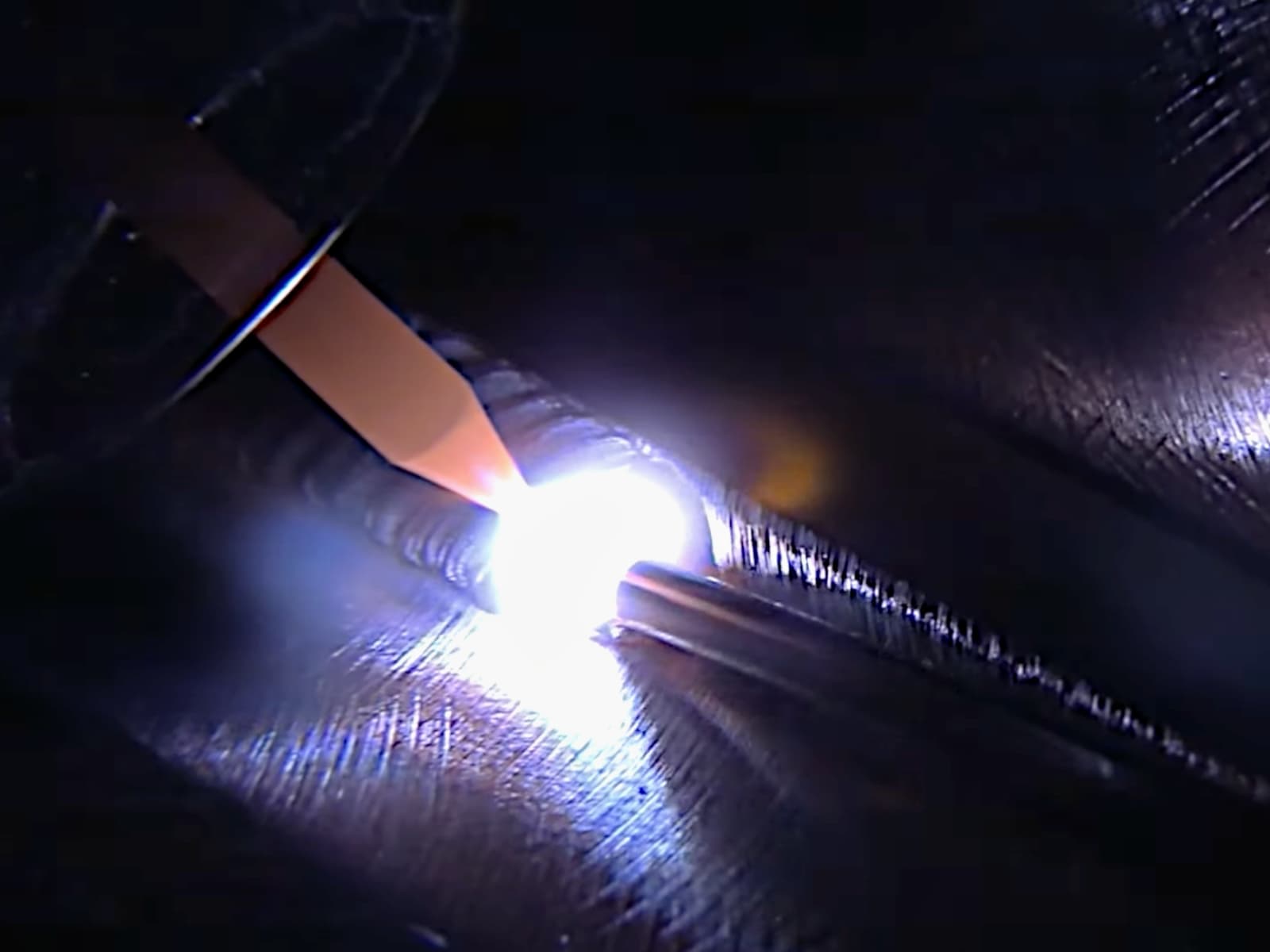
© weldguru.com – Image usage rights
You need to dab the filler rod into the leading edge of the puddle when adding it. The molten puddle of aluminum will melt the filler rod for you.
Doing this will prevent the arc from melting the end of the rod before it gets to the puddle. This will also expose the base metal during AC welding to keep the sandblasting action going to remove the oxide layer.
3. Practice Puddle Control
Aluminum will heat up very quickly as you start to weld it. This means that as you weld, the metal will need less additional heat to melt.
One way to deal with this is to ease up on the foot pedal as the material gets hotter. This lets you maintain your travel speed and the puddle size as the metal heats up.
Another way is to use the hot and fast rule. Use enough amps to start the puddle quickly, then start welding immediately.
Move along the joint at a good travel speed to give you a consistent puddle size. This method gives good penetration and, because it’s faster, also reduces the overall heat input.
4. Experiment With Advanced Settings
Most TIG welders will come with a suite of advanced settings. You should experiment with them on some scrap material to see the effects on your welds.
Play around with the AC balance to see where you get the best cleaning action on your welds, and adjust the AC frequency to see the effects on the bead shape and size.
You can also play around with starting amps, crater fill, and other advanced settings, which will help to improve your welds.
One important point is to adjust one setting at a time. This way, you know which setting had which effect on the weld.
5. Always Be Comfortable
Being comfortable is essential for all welding, but TIG welding is a very unforgiving process.
If you’re not comfortable, it’ll be impossible to move along the joint in a smooth, controlled manner. This will show up in your weld as flaws or inconsistencies.
The best advice I can give you is to always do a dry run of the weld with the machine off before welding. This way, you’ll know what positions feel the most comfortable, and you can experiment without wasting material.
6. End the Weld Slowly
As you get to the end of the weld, the aluminum will be very hot, and you’re running a risk of the end of the joint falling away as you get to it.
Ease up on the foot pedal as you approach the end of the weld, and when you get to the end, decrease the amperage steadily, letting the puddle cool and solidify.
Ensure you add enough filler to avoid having a crater at the end of the weld.
Need more tips? Read: 18 TIG Welding Tips & Techniques
Wrapping It Up
TIG welding on aluminum is a challenge, but with a little practice and knowledge, you can become proficient in no time.
I found that aluminum TIG was a challenge to learn mainly because it responds differently than steel or stainless steel.
Once I understood how aluminum behaves during the TIG welding process, becoming proficient was only a matter of practice, practice, and more practice.
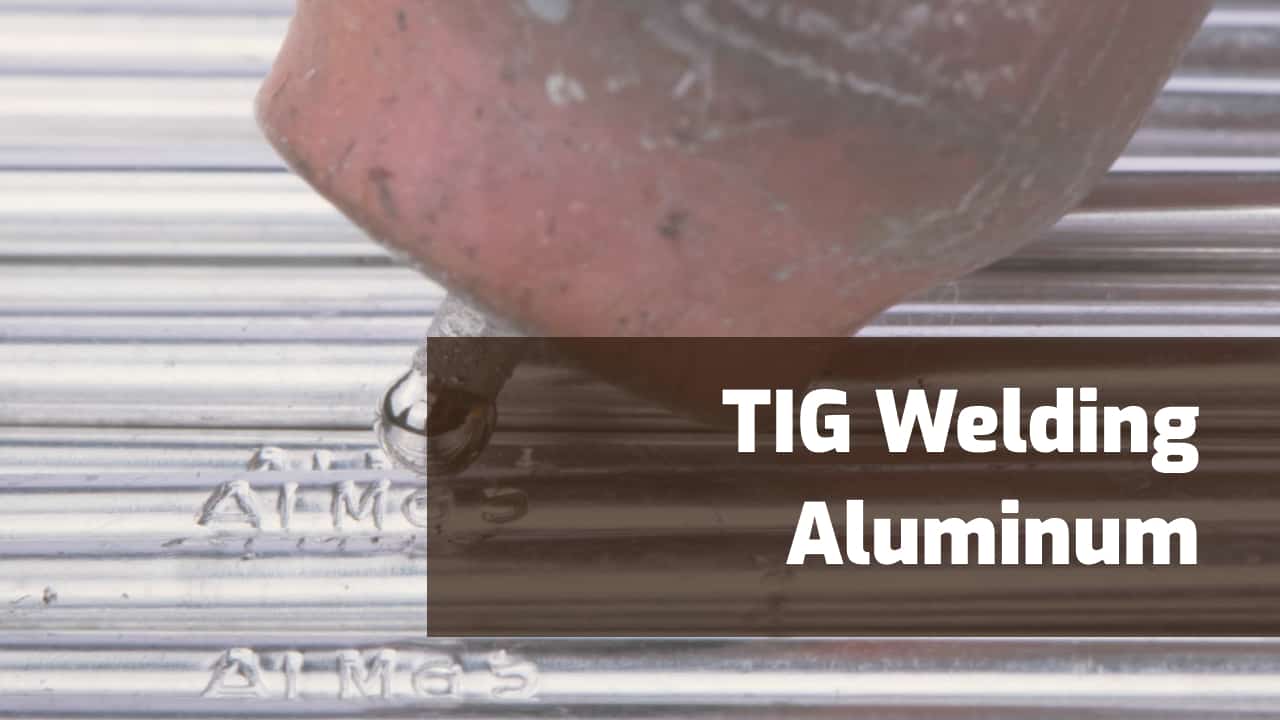
You’ll be hard pressed to find anything decent for that budget. If you’re serious about TIG welding take a look at these under $1000.